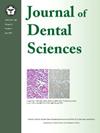Elucidating interfacial failure of cervical restorations using damage mechanics: A finite element analysis
IF 3.4
3区 医学
Q1 DENTISTRY, ORAL SURGERY & MEDICINE
引用次数: 0
Abstract
Background/purpose
Although clinical studies have suggested a link between non-axial forces and reduced longevity of cervical restorations, the underlying mechanisms require further numerical investigation. This in-silico study employed a cohesive zone model (CZM) to investigate interfacial damage in a cervical restoration subjected to different load directions.
Materials and methods
A plane strain model of a maxillary premolar was established, with a wedge-shaped buccal cervical restoration. To simulate debonding, the restoration-tooth interface was modeled by the CZM, which defines the strain-softening damage behavior based on interfacial stress and fracture energy. Occlusal loads were applied in three different directions: (1) obliquely on the buccal triangular ridge, (2) obliquely on the palatal triangular ridge, and (3) equal magnitude axially on both ridges. Damage initiation and progression were analyzed, and stress distribution in damaged models was compared with the corresponding perfect-bond models.
Results
Non-axial oblique loads initiated damage at lower forces (100 N for buccal and 120 N for palatal) compared to axial loads (130 N on both ridges). After debonding, buccal oblique loading caused higher stress at the central groove (42.5 MPa at 150 N). Furthermore, buccal oblique loading resulted in more extensive debonding than that caused by the palatal oblique load (88.3% vs. 43.3% of the bonding interface at 150 N).
Conclusion
The study provides numerical evidence supporting the tooth flexure hypothesis, that non-axial forces are more detrimental to the bonding interface of the cervical restoration. The results highlight the necessity of damage mechanics in deriving stress distribution upon debonding.
利用损伤力学阐明颈椎修复体的界面失效:有限元分析
背景/目的虽然临床研究表明非轴向力与缩短颈椎修复体寿命之间存在联系,但其潜在机制需要进一步的数值研究。本研究采用内聚区模型(CZM)研究不同载荷方向下颈椎修复的界面损伤。材料与方法建立上颌前磨牙平面应变模型,进行楔形颊颈修复。为了模拟脱粘过程,采用基于界面应力和断裂能定义应变软化损伤行为的CZM模型对修复-牙齿界面进行建模。在三个不同的方向上施加咬合负荷:(1)斜向地施加在颊三角脊上,(2)斜向地施加在腭三角脊上,(3)轴向地等量地施加在两脊上。分析了损伤的发生和发展过程,并将损伤模型中的应力分布与相应的完美粘结模型进行了比较。结果与轴向载荷(两侧脊部均为130 N)相比,非轴向斜向载荷在较低的力(颊部为100 N,腭部为120 N)下引发损伤。在150 N时,颊斜载荷在中央槽处造成了更高的应力(42.5 MPa),而在150 N时,颊斜载荷比腭斜载荷造成的脱粘更广泛(88.3%比43.3%)。结论本研究提供了数值证据,支持牙齿弯曲假设,非轴向力对颈椎修复的粘接界面更不利。结果强调了损伤力学在计算剥离时应力分布的必要性。
本文章由计算机程序翻译,如有差异,请以英文原文为准。
求助全文
约1分钟内获得全文
求助全文
来源期刊

Journal of Dental Sciences
医学-牙科与口腔外科
CiteScore
5.10
自引率
14.30%
发文量
348
审稿时长
6 days
期刊介绍:
he Journal of Dental Sciences (JDS), published quarterly, is the official and open access publication of the Association for Dental Sciences of the Republic of China (ADS-ROC). The precedent journal of the JDS is the Chinese Dental Journal (CDJ) which had already been covered by MEDLINE in 1988. As the CDJ continued to prove its importance in the region, the ADS-ROC decided to move to the international community by publishing an English journal. Hence, the birth of the JDS in 2006. The JDS is indexed in the SCI Expanded since 2008. It is also indexed in Scopus, and EMCare, ScienceDirect, SIIC Data Bases.
The topics covered by the JDS include all fields of basic and clinical dentistry. Some manuscripts focusing on the study of certain endemic diseases such as dental caries and periodontal diseases in particular regions of any country as well as oral pre-cancers, oral cancers, and oral submucous fibrosis related to betel nut chewing habit are also considered for publication. Besides, the JDS also publishes articles about the efficacy of a new treatment modality on oral verrucous hyperplasia or early oral squamous cell carcinoma.
 求助内容:
求助内容: 应助结果提醒方式:
应助结果提醒方式:


